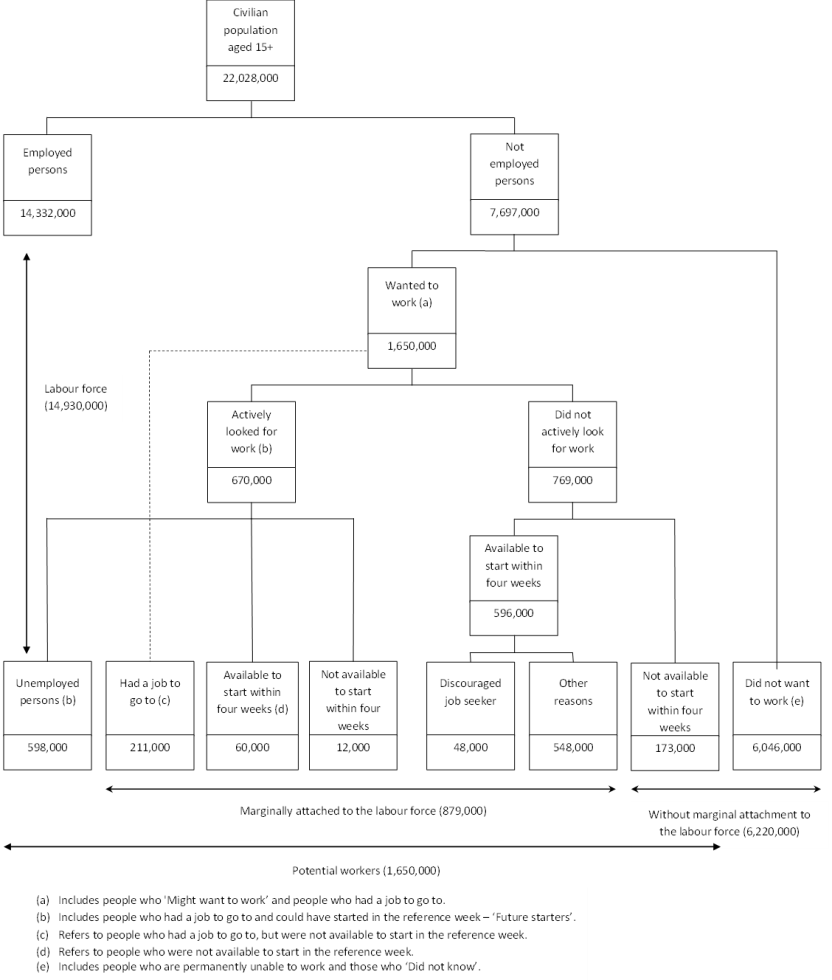Chart 3: Potential workers
[["Feb-15","Mar-15","Apr-15","May-15","Jun-15","Jul-15","Aug-15","Sep-15","Oct-15","Nov-15","Dec-15","Jan-16","Feb-16","Mar-16","Apr-16","May-16","Jun-16","Jul-16","Aug-16","Sep-16","Oct-16","Nov-16","Dec-16","Jan-17","Feb-17","Mar-17","Apr-17","May-17","Jun-17","Jul-17","Aug-17","Sep-17","Oct-17","Nov-17","Dec-17","Jan-18","Feb-18","Mar-18","Apr-18","May-18","Jun-18","Jul-18","Aug-18","Sep-18","Oct-18","Nov-18","Dec-18","Jan-19","Feb-19","Mar-19","Apr-19","May-19","Jun-19","Jul-19","Aug-19","Sep-19","Oct-19","Nov-19","Dec-19","Jan-20","Feb-20","Mar-20","Apr-20","May-20","Jun-20","Jul-20","Aug-20","Sep-20","Oct-20","Nov-20","Dec-20","Jan-21","Feb-21","Mar-21","Apr-21","May-21","Jun-21","Jul-21","Aug-21","Sep-21","Oct-21","Nov-21","Dec-21","Jan-22","Feb-22","Mar-22","Apr-22","May-22","Jun-22","Jul-22","Aug-22","Sep-22","Oct-22","Nov-22","Dec-22","Jan-23","Feb-23","Mar-23","Apr-23","May-23","Jun-23","Jul-23","Aug-23","Sep-23","Oct-23","Nov-23","Dec-23","Jan-24","Feb-24","Mar-24","Apr-24","May-24","Jun-24","Jul-24","Aug-24","Sep-24","Oct-24","Nov-24","Dec-24","Jan-25","Feb-25"],[[97.6],[null],[null],[null],[null],[null],[null],[null],[null],[null],[null],[null],[101],[null],[null],[null],[null],[null],[null],[null],[null],[null],[null],[null],[93.9],[null],[null],[null],[null],[null],[null],[null],[null],[null],[null],[null],[95.4],[null],[null],[null],[null],[null],[null],[null],[null],[null],[null],[null],[106.7],[null],[null],[null],[null],[null],[null],[null],[null],[null],[null],[null],[105.9],[null],[null],[null],[null],[null],[null],[null],[null],[null],[null],[null],[118.5],[null],[null],[null],[null],[null],[null],[null],[null],[null],[null],[null],[114.8],[null],[null],[null],[null],[null],[null],[null],[null],[null],[null],[null],[109.2],[null],[null],[null],[null],[null],[null],[null],[null],[null],[null],[null],[104.2],[null],[null],[null],[null],[null],[null],[null],[null],[null],[null],[null],[60.9]],[[265.6],[null],[null],[null],[null],[null],[null],[null],[null],[null],[null],[null],[263.2],[null],[null],[null],[null],[null],[null],[null],[null],[null],[null],[null],[284.1],[null],[null],[null],[null],[null],[null],[null],[null],[null],[null],[null],[278.4],[null],[null],[null],[null],[null],[null],[null],[null],[null],[null],[null],[300.1],[null],[null],[null],[null],[null],[null],[null],[null],[null],[null],[null],[320.3],[null],[null],[null],[null],[null],[null],[null],[null],[null],[null],[null],[333.3],[null],[null],[null],[null],[null],[null],[null],[null],[null],[null],[null],[357.5],[null],[null],[null],[null],[null],[null],[null],[null],[null],[null],[null],[352.6],[null],[null],[null],[null],[null],[null],[null],[null],[null],[null],[null],[328.3],[null],[null],[null],[null],[null],[null],[null],[null],[null],[null],[null],[271.9]],[[716.9],[null],[null],[null],[null],[null],[null],[null],[null],[null],[null],[null],[681.6],[null],[null],[null],[null],[null],[null],[null],[null],[null],[null],[null],[679.1],[null],[null],[null],[null],[null],[null],[null],[null],[null],[null],[null],[664.9],[null],[null],[null],[null],[null],[null],[null],[null],[null],[null],[null],[617.4],[null],[null],[null],[null],[null],[null],[null],[null],[null],[null],[null],[631.9],[null],[null],[null],[null],[null],[null],[null],[null],[null],[null],[null],[748.4],[null],[null],[null],[null],[null],[null],[null],[null],[null],[null],[null],[495.2],[null],[null],[null],[null],[null],[null],[null],[null],[null],[null],[null],[464.3],[null],[null],[null],[null],[null],[null],[null],[null],[null],[null],[null],[518.4],[null],[null],[null],[null],[null],[null],[null],[null],[null],[null],[null],[608.8]],[[1299.6],[null],[null],[null],[null],[null],[null],[null],[null],[null],[null],[null],[1232.5],[null],[null],[null],[null],[null],[null],[null],[null],[null],[null],[null],[1234],[null],[null],[null],[null],[null],[null],[null],[null],[null],[null],[null],[1205.2],[null],[null],[null],[null],[null],[null],[null],[null],[null],[null],[null],[1118.6],[null],[null],[null],[null],[null],[null],[null],[null],[null],[null],[null],[1115.8],[null],[null],[null],[null],[null],[null],[null],[null],[null],[null],[null],[1213.2],[null],[null],[null],[null],[null],[null],[null],[null],[null],[null],[null],[893.4],[null],[null],[null],[null],[null],[null],[null],[null],[null],[null],[null],[870.8],[null],[null],[null],[null],[null],[null],[null],[null],[null],[null],[null],[945.6],[null],[null],[null],[null],[null],[null],[null],[null],[null],[null],[null],[973.9]],[[1629],[null],[null],[null],[null],[null],[null],[null],[null],[null],[null],[null],[1559.2],[null],[null],[null],[null],[null],[null],[null],[null],[null],[null],[null],[1539.7],[null],[null],[null],[null],[null],[null],[null],[null],[null],[null],[null],[1519.8],[null],[null],[null],[null],[null],[null],[null],[null],[null],[null],[null],[1441.5],[null],[null],[null],[null],[null],[null],[null],[null],[null],[null],[null],[1479.5],[null],[null],[null],[null],[null],[null],[null],[null],[null],[null],[null],[1574],[null],[null],[null],[null],[null],[null],[null],[null],[null],[null],[null],[1223.3],[null],[null],[null],[null],[null],[null],[null],[null],[null],[null],[null],[1209.2],[null],[null],[null],[null],[null],[null],[null],[null],[null],[null],[null],[1309.9],[null],[null],[null],[null],[null],[null],[null],[null],[null],[null],[null],[1192.7]],[[1858.6],[null],[null],[null],[null],[null],[null],[null],[null],[null],[null],[null],[1796.5],[null],[null],[null],[null],[null],[null],[null],[null],[null],[null],[null],[1755.3],[null],[null],[null],[null],[null],[null],[null],[null],[null],[null],[null],[1758.7],[null],[null],[null],[null],[null],[null],[null],[null],[null],[null],[null],[1650],[null],[null],[null],[null],[null],[null],[null],[null],[null],[null],[null],[1701.6],[null],[null],[null],[null],[null],[null],[null],[null],[null],[null],[null],[1806.1],[null],[null],[null],[null],[null],[null],[null],[null],[null],[null],[null],[1429.4],[null],[null],[null],[null],[null],[null],[null],[null],[null],[null],[null],[1429.7],[null],[null],[null],[null],[null],[null],[null],[null],[null],[null],[null],[1550.8],[null],[null],[null],[null],[null],[null],[null],[null],[null],[null],[null],[1378.2]],[[2124.1],[null],[null],[null],[null],[null],[null],[null],[null],[null],[null],[null],[2059.8],[null],[null],[null],[null],[null],[null],[null],[null],[null],[null],[null],[2039.4],[null],[null],[null],[null],[null],[null],[null],[null],[null],[null],[null],[2037.2],[null],[null],[null],[null],[null],[null],[null],[null],[null],[null],[null],[1950.1],[null],[null],[null],[null],[null],[null],[null],[null],[null],[null],[null],[2021.9],[null],[null],[null],[null],[null],[null],[null],[null],[null],[null],[null],[2139.4],[null],[null],[null],[null],[null],[null],[null],[null],[null],[null],[null],[1786.9],[null],[null],[null],[null],[null],[null],[null],[null],[null],[null],[null],[1782.3],[null],[null],[null],[null],[null],[null],[null],[null],[null],[null],[null],[1879.1],[null],[null],[null],[null],[null],[null],[null],[null],[null],[null],[null],[1650.2]],[[203.7],[151.3],[163.4],[147.5],[139],[154],[177.3],[168.6],[172.8],[169.5],[173.1],[301.5],[190.6],[165.2],[154.4],[164.1],[157.1],[179.1],[186.3],[171.6],[178.2],[182.6],[186.6],[307.6],[213.4],[175.8],[167.6],[164.3],[163.6],[188],[175],[149.1],[170.3],[162.7],[170.9],[277.4],[192.2],[166.2],[160.5],[155.6],[160.9],[174.3],[185.2],[163.8],[172.9],[187.3],[179.5],[312.4],[198.7],[188.6],[176.5],[173.2],[182],[181.6],[172.3],[178.3],[192.9],[210.2],[203.6],[327.1],[235.4],[186.5],[309.4],[576.5],[427.2],[354.4],[292.6],[298.8],[284.3],[249.1],[208.8],[351.1],[240.9],[176.2],[198],[185.2],[212.5],[241.3],[372.5],[513.4],[519.5],[273.7],[243.3],[394.8],[259.4],[228.5],[228.2],[216.7],[209.6],[230.2],[229.7],[202.1],[224.8],[204.2],[230.1],[409.3],[264.1],[206.3],[209.6],[195.9],[211.6],[227.5],[224.7],[225.3],[210.8],[214.3],[230.1],[420.4],[241.3],[219.2],[222.8],[204.8],[192.2],[232.7],[212.9],[204.2],[211.2],[217.6],[194.3],[362.5],[250.1]],[[765.2],[759.9],[760.9],[739.8],[749.5],[788],[762.8],[775.8],[745.5],[739.1],[725.1],[765.7],[719.8],[715.4],[714.5],[724.6],[722.4],[724.9],[711.6],[717.5],[709.5],[733.7],[744.7],[725.1],[752],[749.4],[720.3],[714.4],[726.7],[727.2],[719.3],[712.9],[704.7],[713.6],[737.5],[726.6],[733.6],[727.9],[730.4],[715.7],[706.8],[701.3],[697.1],[667],[665.6],[680.9],[669.1],[675.3],[667.5],[682.9],[702.9],[701],[711.1],[716.6],[715.7],[713.6],[721],[702.3],[685.4],[715.2],[695.1],[707.3],[828.9],[904.8],[986.2],[1000.6],[916.2],[934.9],[947.8],[931.3],[896.8],[858.4],[798.3],[776.1],[747.5],[700.8],[692.7],[651],[621.4],[637.3],[708.4],[638.5],[579.5],[576.4],[559.5],[552.3],[538.1],[551.6],[510.4],[487.1],[500],[515.2],[489.7],[501.9],[500.9],[522.6],[515.9],[515.3],[534.8],[520.1],[514.9],[542.9],[538.9],[526.5],[557.8],[580.8],[584.2],[601.1],[551.3],[572.2],[606.7],[595.3],[607.4],[632.7],[621.1],[613.4],[619.8],[593.3],[601.1],[623.8],[612.6]]]
[]
[{"value":"0","axis_id":"0","axis_title":"","axis_units":"","tooltip_units":"","table_units":"","axis_min":null,"axis_max":null,"tick_interval":null,"precision":"-1","data_unit_prefix":"","data_unit_suffix":"","reverse_axis":false}][{"value":"0","axis_id":"0","axis_title":"('000)","axis_units":"","tooltip_units":"('000)","table_units":"('000)","axis_min":"0","axis_max":"2500","tick_interval":null,"precision":"1","data_unit_prefix":"","data_unit_suffix":"","reverse_axis":false}]